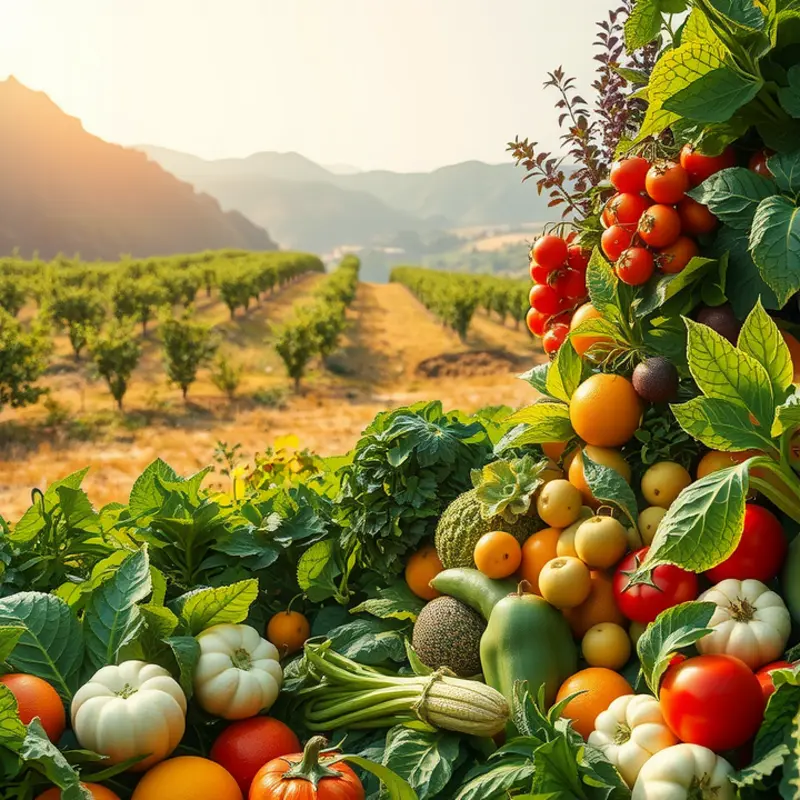Food goes beyond mere sustenance; it embodies history, tradition, and cultural identity. Culinary practices are often steeped in stories, ancestral wisdom, and the artistry of generations. As food enthusiasts and culturally-curious readers, understanding how these unique dishes come to symbolize identity can deepen appreciation for diverse global cuisines and foster connection across cultures. Let’s delve into the rich tapestry of foods that reflect cultural heritage and explore how they continue to resonate in our modern world.
The Heart of the Meal: Bread and Identity

Bread has been a staple in human diets for thousands of years, representing sustenance, community, and cultural continuity. Each culture around the world boasts its own unique bread, woven into the fabric of daily life and celebratory occasions alike.
In the Middle East, bread serves as a communal centerpiece. Traditional pita bread, often baked in clay ovens, invokes warm memories of family meals. Shared among friends and family, it symbolizes the fundamentals of hospitality, where breaking bread is synonymous with creating bonds.
Moving eastward, naan in India plays a critical role in culinary traditions. Baked against the walls of tandoor ovens, its soft yet slightly crispy texture complements a variety of curries and vegetable dishes. It stands as a testament to the blending of flavors and craftsmanship in Indian cuisine.
Meanwhile, in European societies, sourdough bread holds a revered place. The use of natural fermentation reflects ancient bread-making practices, linking generations through both taste and technique. Notably, in San Francisco, sourdough is not only a food item but a slice of the city’s history, connecting residents to its Gold Rush era.
In Latin America, tortillas serve as both plate and meal. Made traditionally from maize, they embody the region’s rich agricultural heritage and form a daily staple in countries like Mexico, where there are few meals without this versatile bread. Tortillas are not just food; they are an expression of identity and sustenance rooted in the earth.
Australia offers the damper, a simple yet iconic bread, historically associated with bush cooks and explorers. Its simple ingredients highlight resourcefulness and adaptability in the face of necessity, echoing the stories of survival and self-reliance.
In almost every culture, bread signifies more than just body nourishment—it nurtures connections. For example, bread plays a symbolic role in the Jewish Sabbath (Shabbat) in the form of challah, a braided bread that graces the dinner table, linking religious tradition with family gathering. Similarly, in Christian communities, bread is part of the Eucharistic tradition, acting as a vital symbol of spiritual union.
As highlighted in the broad spectrum of global traditions, bread’s role extends beyond mere food. It embodies a powerful link between past and present, connecting people through shared meals and memories. The journey from grain to loaf carries with it the stories of countless hands, each touch adding layers of meaning and continuity.
For an exploration of culinary influences through historical trade routes, you can read more at Culinary Influences from Trade. This connection between food and culture underscores the intrinsic role that staple foods like bread play in our identities, bringing the world closer, one loaf at a time.
Beyond Borders: Spices That Define Cultures

Spices are more than mere flavor enhancers. They’re the threads that weave together the rich tapestries of cultural identity. The journeys of spices like saffron, chili, and cumin are marked by tales of trade, migration, and adaptation, deeply influencing the culinary landscapes they touch. Saffron, with its delicate threads, has long been celebrated for its golden hue and unique flavor. Originating from regions around the Mediterranean, saffron’s route across Europe, Asia, and into the Americas mirrors ancient trade routes. As merchants traveled, they not only carried spices but also introduced new ways of life. In Spain, the use of saffron in paella has become a hallmark of their culinary tradition, while in Persian cuisine, it adds unparalleled depth to dishes like tahchin and fesenjan.
Chilies, meanwhile, possess a history as fiery as their flavor profile. Native to the Americas, chilies were spread across the globe in the wake of the Columbian Exchange. This migration not only changed the agronomical landscape but also transformed culinary practices worldwide. In India, chilies became integral to traditional dishes like curries, lending a burst of heat that defines the country’s palate. Across the continents, from the spicy kick of Mexican salsas to the peppery depth of Korean kimchi, chilies exemplify how a single ingredient can reshape regional cuisines.
Cumin, often overshadowed by more flamboyant spices, carries a subtle complexity that can surprise even seasoned cooks. As one of the earliest spices used by humans, cumin’s journey spans from the Middle East through North Africa and into South America. Its robust, earthy flavor underpins Moroccan tagines, while in Mexico, it adds a savory note to tacos al pastor and traditional beans. The ability of cumin to transcend regional boundaries illustrates the interconnectedness of our global culinary heritage.
Spices also play an educational role, inviting us to explore diverse cultures through our senses. The aroma of freshly toasted cumin seeds can transport one to an open-air market in Marrakech, while the scent of saffron blooming in warm milk might evoke images of a bustling Persian kitchen. This sensory experience bridges geographical and cultural gaps, fostering a greater understanding and appreciation of global culinary traditions.
Furthermore, the adaptation of spice usage illustrates human resilience and creativity in the culinary arts. As spices traveled, each culture interpreted them differently, adapting them to local tastes and ingredient availability. Such adaptation speaks to a broader narrative of hybridization in food, creating cross-cultural cuisines that pay homage to multiple traditions while crafting new identities. For those interested in how international influences shape local dishes, the exploration of culinary influences through trade provides invaluable insights.
As spices continue to enrich our kitchens and stories, they remind us of the shared humanity behind every dish. They stir not only our pots but also the connections that make culinary traditions vibrant and meaningful across the world. This ongoing journey of spices is a testament to the power of flavor to unite and define cultures, transcending borders in the most delicious of ways.
Final words
Food not only nourishes the body but also nurtures our understanding of identity and culture. By exploring unique foods, we unravel narratives that connect us across geographies and generations. Breads and spices are just two examples of how culinary traditions encompass a wealth of histories and shared experiences, each bite telling a story. Embracing these diverse flavors can inspire curiosity and appreciation for the intricate tapestry of global cuisines. As you relish your next meal, consider the ingredients and stories that intertwine our lives and celebrate the rich culinary heritage that defines who we are.








